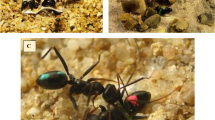Summary.
We studied the dealation of a subterranean termite Reticulitermes speratus Kolbe from three different angles; mechanism, induction factors, and adaptive significance. During nuptial flight alates prevent the wings from breaking off by holding the wings in a 3-dimensional configuration. In the process of dealation, the alates hold the wings in a 2-dimensional configuration, half spread the wings in a lowered position, and bend the abdomen back toward the wings, thereby exerting high pressure at the basal sutures. This separates the wings from the body. The primary factor determining the timing of dealation appears to be isolation from other alates: It induces alates to shed their wings, whereas pairing has no effect on dealation in this species. Alates of termites are especially vulnerable to ant predation during the period between flight and colony foundation. An experiment designed to compare the risk of alates and dealates to predation by a termite-hunting ant, Brachyponera chinensis Emery, showed that dealation reduced the predation risk during the period spent running on the ground.
Similar content being viewed by others
Author information
Authors and Affiliations
Additional information
Received 24 July 2001; revised 20 March 2002; accepted 9 April 2002.
Rights and permissions
About this article
Cite this article
Matsuura, K., Nishida, T. Mechanism, induction factors, and adaptive significance of dealation in the subterranean termite Reticulitermes speratus (Isoptera, Rhinotermitidae). Insectes soc. 49, 241–244 (2002). https://doi.org/10.1007/s00040-002-8308-9
Issue Date:
DOI: https://doi.org/10.1007/s00040-002-8308-9




